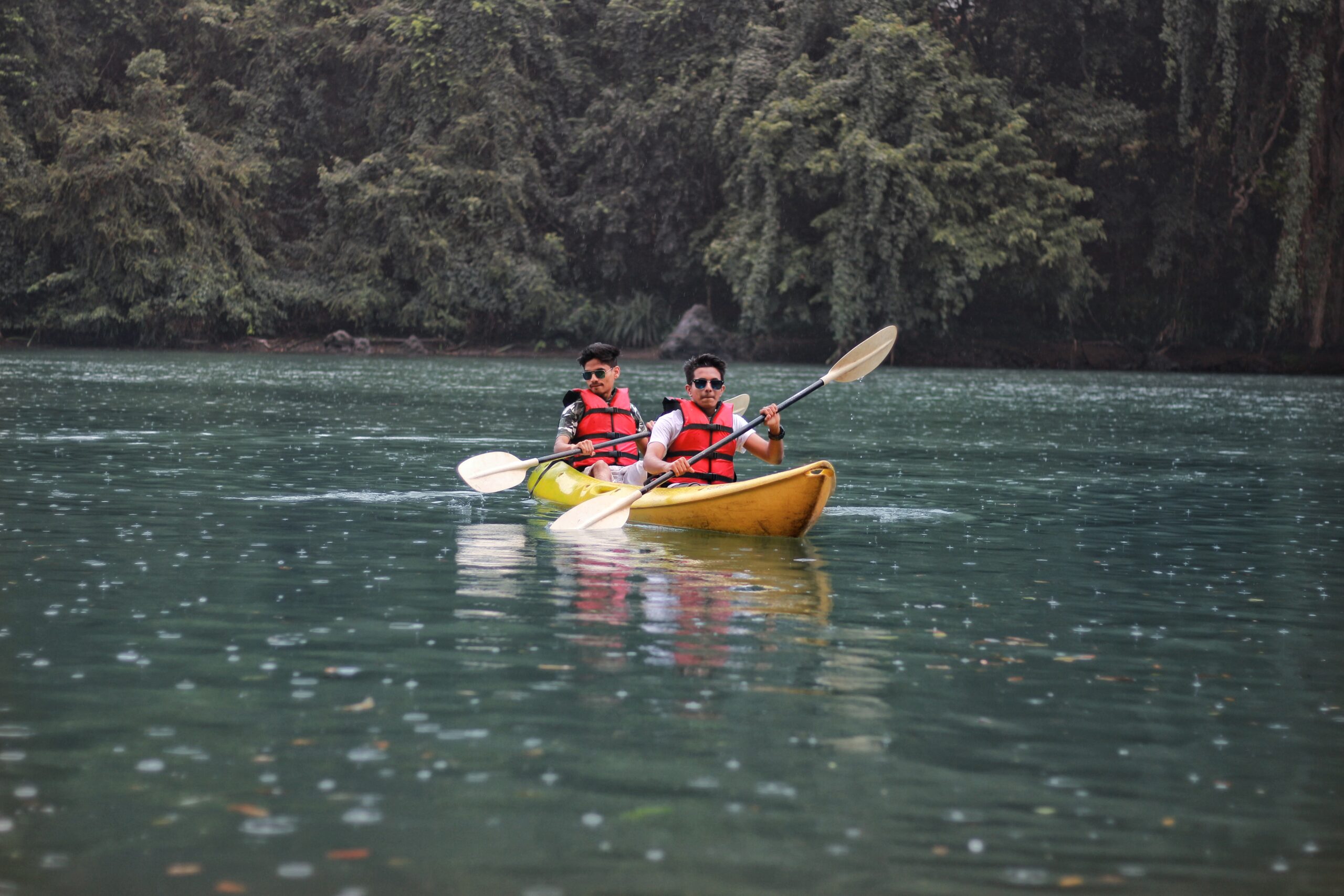
So, you’ve just purchased two shiny new kayaks, and you can’t wait to hit the open waters. The only problem is, you need to transport them safely and securely in your truck bed. Don’t worry, we’ve got you covered! In this step-by-step guide, we’ll show you exactly how to tie down two kayaks in your truck bed, ensuring they stay put during even the bumpiest of rides. With a few simple tools and some careful maneuvering, you’ll be hitting the waves in no time!
Step 1: Prepare the Truck Bed
Before securing your kayaks in the truck bed, it’s essential to properly prepare the space. This will ensure the safety of your kayaks and prevent any damage during transit.
Clean the truck bed
Start by cleaning the truck bed to remove any dirt, debris, or loose objects. Sweep or hose down the bed to make sure it’s free from any potential hazards that could scratch or damage your kayaks.
Remove any debris or obstructions
Inspect the truck bed for any remaining debris, such as rocks or tree branches, that may have been missed during the cleaning process. Safety is crucial, and removing these obstructions will prevent any accidents or damage to your kayaks.
Inspect the truck bed for any sharp edges or protrusions
Carefully inspect the truck bed for any sharp edges, rough surfaces, or protrusions that could potentially damage your kayaks. These can be potentially hazardous and cause unexpected scratches or dents. If you find any, consider sanding down or covering them to create a smooth surface.
Consider using a truck bed liner or padding for added protection
To further protect your kayaks during transportation, you may want to consider using a truck bed liner or padding. These provide an extra layer of cushioning and help prevent any unwanted movement that can occur during transit. Investing in a liner or protective padding is a worthwhile expense to ensure your kayaks arrive at their destination safely.
Step 2: Gather the Necessary Equipment
To secure two kayaks in a truck bed, gather the following equipment before you begin the process:
Ratchet straps
Ratchet straps are essential for securing your kayaks firmly in place. Look for sturdy straps that have a high weight capacity and are specifically designed for securing heavy loads. These straps will be used to hold the kayaks tightly to the anchor points in the truck bed.
Cam buckle straps
Cam buckle straps provide additional security by attaching to the front and rear of each kayak. These straps typically have a simpler design and are easy to adjust for added convenience. Choose straps that are compatible with the tie-down points in your truck bed or have secure anchor points for a reliable connection.
Foam blocks or kayak carriers
Place foam blocks or kayak carriers in the truck bed to provide a stable base for your kayaks. These accessories help to distribute the weight of the kayaks evenly and prevent any direct contact between the kayaks and the truck bed. Foam blocks are a cost-effective option, while kayak carriers offer more secure and convenient storage for your kayaks.
Bow and stern lines
Bow and stern lines are crucial for ensuring the stability of your kayaks during transportation. These lines are attached to the front and rear of each kayak and then secured to anchor points in the truck bed. They help to prevent any lateral movement or shifting of the kayaks while driving.
Tarp or cover (optional)
If you want to provide an extra layer of protection for your kayaks, consider using a tarp or cover. This optional step can shield your kayaks from dirt, dust, or debris during transit. Ensure that the tarp or cover does not interfere with the stability of the kayaks or the straps.

Step 3: Position the Kayaks in the Truck Bed
Properly placing the kayaks in the truck bed is key to maintaining stability and reducing the risk of damage. Follow these steps to position the kayaks correctly:
Place foam blocks or kayak carriers in the truck bed
Start by placing foam blocks or kayak carriers in the truck bed. These will create a stable and secure base for your kayaks, preventing them from shifting during transit. Make sure the foam blocks or carriers are evenly spaced and aligned with the length of the truck bed.
Position the kayaks parallel to each other
Carefully position the kayaks in the truck bed, ensuring they are parallel to each other. This arrangement will help optimize space and prevent any unnecessary movement during transportation. Alignment is crucial to maintain stability, so take the time to position the kayaks accurately.
Ensure the kayaks are centered and aligned with the length of the truck bed
Double-check that the kayaks are centered in the truck bed and aligned with its length. This step ensures an even distribution of weight and minimizes the risk of the kayaks shifting or becoming unbalanced during the journey. Proper alignment is crucial for safe and secure transportation.
Leave an adequate gap between the kayaks and the sides of the truck bed
When positioning the kayaks in the truck bed, be mindful to leave adequate space between the kayaks and the sides of the truck bed. This gap acts as a safety buffer and prevents any potential damage caused by movement or friction. It’s important to maintain this distance to keep your kayaks secure and protected.
Step 4: Secure the Kayaks with Ratchet Straps
Ratchet straps are an integral part of securing your kayaks in the truck bed, providing a strong and reliable hold. Follow these steps to properly secure your kayaks:
Attach one end of the ratchet strap to a secure anchor point in the truck bed
Start by attaching one end of the ratchet strap to a secure anchor point in the truck bed. This can be a tie-down point or a secure attachment point designed for load securing. It’s essential to use a strong anchor point that can withstand the tension required to hold the kayaks securely.
Thread the ratchet strap through a kayak’s carrying handle or secure attachment point
Thread the loose end of the ratchet strap through one of the kayak’s carrying handles or a secure attachment point. Ensure the strap is positioned in a way that allows you to easily tighten it later. Proper threading creates a strong connection that will hold the kayak firmly in place during transit.
Pull the strap tight and ratchet it to secure the kayak
Pull the loose end of the ratchet strap tight, removing any slack, and begin ratcheting it to tighten the connection. A well-tensioned strap provides optimal security for your kayak. Ratchet the strap until it is taut and ensure that the kayak is firmly held in place without any visible movement.
Repeat the process for the other kayak, adjusting the tension as needed
After securing the first kayak, repeat the process for the second one. Attach the ratchet strap to a secure anchor point in the truck bed, thread it through the kayak’s carrying handle or attachment point, and ratchet it tight. Adjust the tension of both straps as needed to ensure both kayaks are secure and stable.

Step 5: Use Cam Buckle Straps for Added Security
In addition to ratchet straps, using cam buckle straps provides an extra layer of security for your kayaks. Follow these steps to properly utilize cam buckle straps:
Attach the cam buckle straps to the front and rear of each kayak
Start by attaching the cam buckle straps to the front and rear of each kayak. Look for sturdy attachment points on the kayak where the straps can be securely fastened. Taking the time to locate these points will ensure a reliable connection between the straps and the kayaks.
Thread the strap through the tie-down points in the truck bed or secure anchor points
Thread the loose end of the cam buckle strap through the tie-down points in the truck bed or secure anchor points. These points are typically designed to accommodate straps and provide a secure attachment. Ensure that the straps are threaded tightly through these points to create a stable connection.
Ensure the straps are snug and secure, but not overly tight
After threading the straps, make sure they are snug and secure around the kayaks. Avoid over-tightening, as this can cause unnecessary strain on the kayaks. The straps should provide additional security without distorting the shape or structure of the kayaks.
Double-check the strap tension before continuing
Before moving on to the next step, double-check the tension of the cam buckle straps. Ensure that they are properly and evenly tightened for maximum security. This thorough check will give you peace of mind knowing that your kayaks are well-secured and ready for transport.
Step 6: Secure the Bow and Stern of Each Kayak
To further enhance the stability of your kayaks, securing the bow and stern of each kayak is vital. Follow these steps to properly secure the bow and stern:
Attach a bow line to the bow handle or grab loop of each kayak
Attach a bow line to the bow handle or grab loop of each kayak. This line will be responsible for securing the front end of the kayak to an anchor point in the truck bed. Choose a sturdy bow line that can handle the tension required to keep the kayak stable during transit.
Secure the other end of the bow line to a strong anchor point at the front of the truck bed
Once the bow line is attached to each kayak, secure the other end of the line to a strong anchor point at the front of the truck bed. Ideally, this anchor point should be near the front of the truck and capable of providing a stable connection. Double-check the tension of the bow lines to ensure the kayaks are secure.
Attach a stern line to the stern handle or grab loop of each kayak
Similarly, attach a stern line to the stern handle or grab loop of each kayak. This line will secure the rear end of the kayak, adding an extra layer of stability during transportation. Ensure the stern lines are attached firmly to the kayaks’ sterns, as this will help prevent lateral movement.
Secure the other end of the stern line to a strong anchor point at the rear of the truck bed
Finally, secure the other end of the stern line to a strong anchor point at the rear of the truck bed. This anchor point should be located near the rear of the truck and should withstand the tension required to keep the kayaks stable. Check the tension of the stern lines to ensure the kayaks are securely fastened.

Step 7: Check the Stability and Tightness of the Straps
After securing the kayaks using ratchet straps, cam buckle straps, and bow and stern lines, it’s crucial to check the stability and tightness of the straps. Follow these steps for a thorough examination:
Ensure all straps are properly tensioned
First, make sure that all of the straps you previously attached are properly tensioned. Check that the ratchet straps and cam buckle straps are tightened adequately without causing any distortions or damage to the kayaks. Properly tensioned straps are key to maintaining stability during transit.
Check for any signs of looseness or shifting
Inspect the straps for any signs of looseness or shifting. Look for any areas where the straps may have come undone or loosened due to vibration or movement. Identifying these issues early can prevent further problems and ensure the safety of your kayaks.
Give each kayak a gentle shake and verify its stability
Give each kayak a gentle shake to test its stability. The kayaks should remain firmly in place without any noticeable movement. If you detect any instability or shifting, address the issue immediately by adjusting the straps or tie-downs. Stability is crucial for safe transporting.
Make any necessary adjustments to the straps or tie-downs
If you encounter any signs of looseness, shifting, or instability, make the necessary adjustments to the straps or tie-downs. This may involve tightening straps, repositioning foam blocks or carriers, or readjusting anchor points. Taking the time to make these adjustments ensures the safety and security of your kayaks.
Step 8: Optional: Cover the Kayaks with a Tarp or Cover
For an added layer of protection, you may choose to cover your kayaks with a tarp or cover. While this step is optional, it can help safeguard your kayaks from dirt, dust, or debris during transit. Follow these steps for covering your kayaks:
Place a tarp or cover over the kayaks to protect them from dirt, dust, or debris
Carefully place a tarp or cover over the kayaks, ensuring that they are fully covered and protected. The tarp or cover acts as a shield, preventing any unwanted elements from coming into contact with your kayaks during transportation. It provides an extra layer of protection to keep your kayaks clean and in pristine condition.
Secure the tarp or cover with bungee cords or additional straps
To keep the tarp or cover securely in place, use bungee cords or additional straps. These will prevent the cover from shifting or coming loose during transit. Make sure the tarp or cover is tightly secured while still allowing for proper airflow to prevent moisture build-up.
Ensure the tarp or cover does not interfere with the stability of the kayaks or the straps
While covering your kayaks, ensure that the tarp or cover does not interfere with the stability of the kayaks or the straps. Double-check that the cover doesn’t create any obstructions or looseness that could compromise the security of your kayaks. The cover should enhance protection without compromising the overall stability of your load.
Step 9: Test Drive and Monitor While in Transit
Before hitting the road for an extended journey, it’s crucial to take a short test drive and monitor the stability of your kayak setup. Follow these steps to ensure everything is secure:
Take a short test drive to assess the stability of the kayak setup
Before embarking on your trip, take a short test drive to evaluate the stability of your kayak setup. Pay attention to any unusual noises, vibrations, or signs of instability during this test drive. This initial assessment will allow you to make any necessary adjustments before committing to a longer journey.
Pay attention to any shifting, rattling, or unusual noises
Throughout the test drive and the subsequent journey, pay close attention to any shifting, rattling, or unusual noises. These signs may indicate that the kayaks are not properly secured or that the straps require adjustment. Address these issues immediately to prevent any damage to your kayaks or the vehicle.
Periodically check the straps and tie-downs during the journey
During the journey, periodically check the straps and tie-downs to ensure they remain properly tensioned and secure. Use any rest stops or breaks in your trip to inspect the stability of your kayak setup. This simple check can prevent any potential problems and ensure the continued safety of your kayaks.
Make adjustments as needed to maintain a secure and stable load
If at any point during your journey you notice any issues with the stability of your kayak setup, make the necessary adjustments immediately. Tighten loose straps, reposition foam blocks or carriers if needed, and ensure all anchor points are secure. Maintaining a secure and stable load is essential for a safe and stress-free trip.
Step 10: Unloading the Kayaks
Once you’ve reached your destination, it’s time to safely unload your kayaks from the truck bed. Follow these steps to successfully complete the unloading process:
Park the truck in a safe and level area
Find a safe and level area to park your truck before unloading the kayaks. This ensures stability and reduces the risk of any accidents or damage during the unloading process. Prioritize safety and choose a location that provides ample space to maneuver.
Carefully remove the tarp or cover
If you covered your kayaks with a tarp or cover, carefully remove it to reveal your kayaks. Handle the tarp or cover with care to prevent any debris or dirt from falling onto your kayaks during removal. Fold or roll the tarp or cover neatly for easy storage.
Remove the bow and stern lines from the truck bed anchor points
Start by removing the bow and stern lines from the anchor points in the truck bed. Untie or unfasten them carefully, ensuring that the lines are not tangled or caught on any other equipment. Stow the lines securely for future use.
Release the tension on the ratchet straps and cam buckle straps
To release the kayaks from their secure hold, release the tension on the ratchet straps and cam buckle straps. Unratchet the straps slowly and steadily, ensuring that there is no sudden release of tension. This controlled process prevents any potential injuries or damage.
Gently lift and remove the kayaks from the truck bed
Once all straps and lines have been released, gently lift the kayaks from the truck bed. Use proper lifting techniques and, if necessary, ask for assistance to prevent any strain or injury. Avoid dragging the kayaks, as this can cause damage to their surfaces. Carefully place the kayaks on the ground or any designated storage area.
Remember, safety should always be your top priority when securing and transporting your kayaks. Following these steps will help ensure a secure and stable load, allowing you to enjoy stress-free journeys with your kayaks.









